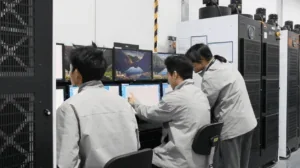Recently, the International Maritime Organization issued the International Maritime Dangerous Goods Code (IMDG Code (Amendment 42-24) 2024 EDITION), which will be applicable from January 1, 2025 and enforced from January 1, 2026. This update is consistent with the 23rd edition of the Model Regulations. The following are the changes to the battery section:
Article No. | theme | Changes |
Chapter 2 Classification | ||
2.9 | Category 9 | 2.9.2.2—New sodium-ion battery entries have been added to the subdivision list of Class 9 and include two new UN numbers, UN 3551 and UN 3552: |
2.9.4.7—A new note has been added to clarify the meaning of “available” for manufacturers and distributors who prepare test summaries in accordance with the provisions of the Manual of Tests and Criteria, Part III, Section 38.3, paragraph 38.3.5. | ||
2.9.5—This is a new section on sodium-ion batteries, and its requirements are consistent with those in 2.9.4 for lithium batteries. | ||
Chapter 3 List of Dangerous Goods, Special Provisions and Exceptions | ||
3.2 | Dangerous Goods List (DGL) | Revisions: ● UN 3171—This entry now applies only to vehicles and equipment powered by wet batteries, sodium metal batteries or sodium alloy batteries, which are transported with the batteries installed in the vehicle and equipment. ● UN 3292—The “containing sodium” in the shipping name is changed to “containing metallic sodium or sodium alloy”, clarifying that sodium ion batteries are not included in this scope. |
New: ● UN 3551, Sodium ion batteries with organic electrolyte; ● UN 3552, Sodium ion batteries contained in equipment or packed with equipment, with organic electrolyte. ● UN 3556, Vehicles powered by lithium ion batteries; ● UN 3557, Vehicles powered by lithium metal batteries; ● UN 3558, Vehicles powered by sodium ion batteries. | ||
3.3 | Special Provisions | Revisions: SP188—Revised scope of application, now applicable to exemptions for lithium-ion/sodium-ion cells and batteries. SP230—Added new applicable scope: sodium-ion batteries. Sodium-ion cells and batteries may be transported under this entry if they comply with the provisions of 2.9.5.
SP961 – Exemption from the provisions of the IMDG Code for vehicles meeting certain requirements, i.e., vehicles that meet the requirements may be transported as non-dangerous goods. The first sentence has been reworded and references existing SP388, new SP977, and Packing Instruction P912. A new paragraph has been added regarding the exemption for vehicles powered by sodium-ion batteries, i.e., the vehicle is powered entirely by sodium-ion batteries and the batteries are connected in a short-circuit manner so that the batteries contain no electrical energy. The short-circuit connection should be easily identifiable (e.g., a busbar between the terminals). SP962—Applies to vehicles that do not meet the exemption requirements in SP961 and are classified as Class 9. New requirements for installed batteries, which should comply with the provisions of SP388 or SP977 (as applicable) and be protected from damage, short circuits and accidental activation during transportation. Clarifies that the provisions of this rule related to marking, labeling, placards and marine pollutants only apply to vehicles that are completely enclosed by packaging, crating or other means that prevent immediate identification (e.g., multipacks). |
New: SP400—New entry for sodium-ion cells or batteries, which are exempt if they meet certain conditions. SP401—UN numbering of sodium-ion batteries containing organic electrolytes and aqueous alkaline electrolytes. SP404—Applies to UN 3558, providing conditions under which vehicles powered by sodium-ion batteries (not containing other dangerous goods) are not subject to other provisions of the IMDG Code, provided that short circuiting of the battery can be easily verified. SP405—Applies to new vehicle entries, exempting from marking and labeling requirements if not completely enclosed in packaging. SP977—Specifies that the new entry for “vehicles powered by sodium-ion batteries” must comply with the provisions of section 2.9.5. | ||
Chapter 4 Packaging and Tank Regulations | ||
4.1 | Use packaging, including intermediate bulk containers (IBCs) and large packaging | Revision: P903—This provision applies to batteries transported as dangerous goods. New applicable entries UN 3551 and UN 3552 are added, no longer limited to “lithium” batteries and cells. |
New: P912 – Applicable to new vehicle entries, UN 3556, UN 3557 and UN 3558, requiring the vehicle to be secured in a rigid outer packaging that is strong enough for its intended use. These packagings do not need to meet the requirements of 4.1.1.3 (i.e. conform to the design type) and may exceed a net mass of 400 kg. If the net mass exceeds 30 kg, the vehicle may be transported unpacked. | ||
Note: “LP” indicates the use of large packaging. Large packaging are packaging consisting of an outer packaging containing multiple articles or inner packaging and which (a) are designed for mechanical loading and unloading; and (b) exceed 400 kg net mass or 450 litres capacity but do not exceed 3 m3 in volume. | ||
Chapter 5 Consignment | ||
5.2 | Marking and labeling of packaging | 5.2.1.10—Lithium battery marking requirements now also apply to the new sodium ion battery entry. 5.2.2.1.13.1—Applicable to labels for articles containing dangerous goods, the provisions that previously applied to lithium batteries now also apply to sodium ion batteries. |





